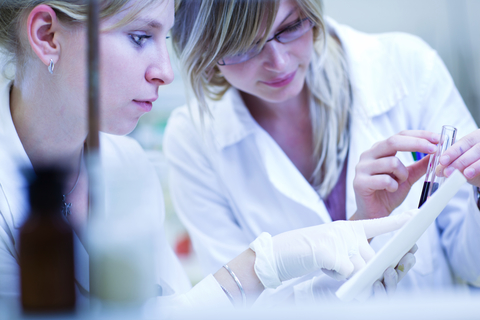Doctors move closer to creating babies with DNA from three people

Doctors are a step closer to creating babies with DNA from three people after research on healthy embryos found the procedure was likely to produce normal pregnancies (The Guardian, 2016).
Studies on embryos made with extra DNA showed that the majority were indistinguishable from standard IVF embryos, although further tests hinted that the procedure still carried risks. The work will be reviewed by the UK government’s fertility regulator, which is expected to make a recommendation on whether or not to approve the treatment under licence before the end of the year.
The experimental technique, known as mitochondrial donation, has been developed by researchers at the Wellcome Trust Centre for Mitochondrial Disease at Newcastle University to prevent women from passing on devastating and often fatal genetic diseases to their children (Newcastle University, 2016). The illnesses, many of which affect the brain and muscles and worsen as children grow, are produced by genetic mutations in tiny structures called mitochondria that sit inside cells and provide them with energy. They are passed on exclusively from mother to child, but mothers can be carriers without having symptoms. Using mitochondrial donation, doctors hope to block the transmission of faulty mitochondrial DNA by making IVF embryos that have the normal set of chromosomes from the parents, but healthy mitochondria from a donor.
In 2010, Doug Turnbull of the Wellcome Trust Centre for Mitochondrial Disease at Newcastle University, UK, and his colleagues showed that the technique worked, but at the time its safety could not be verified because they used donor eggs discarded from IVF treatments because of defects, which meant it was not possible to find out if healthy embryos could result (New Scientist, 2016). Now they have performed the same technique more than 200 times using healthy donor eggs. Doug Turnbull said “We can’t say any procedure is 100-per-cent safe. I think we have to move along respectfully and appropriately, but as a group of scientists and clinicians, we are working as hard as possible to make this available to patients.”
In earlier experiments, Doug Turnbull’s team found that some of the faulty mitochondrial DNA still ended up in the embryo, because residues of fluid from the mother’s egg stick to the nucleus when it is extracted. Now, the technique has been improved to reduce the amount of faulty mitochondria carried over. This was achieved through more careful extraction of the nucleus, and from manipulating the chemical solution used during extraction.
In research published in Nature, the team led by Doug Turnbull and Mary Herbert describe a broad range of experiments on the safety of one particular form of mitochondrial donation, called pronuclear transfer (PNT). In PNT, the mother’s egg is fertilised with the father’s sperm using standard IVF procedures. Before the egg has a chance to divide into two cells, the parents’ chromosomes are plucked out and dropped into a fertilised egg from a healthy donor, which has had its own chromosomes removed. Of the embryos created, 79% had less than 2% faulty mitochondrial DNA. And in 42% of those there was no detectable faulty mitochondrial DNA at all. Putting this in perspective, the amount of defective mitochondrial DNA you would expect to see in a natural conception by a woman carrying the disease would vary from under 10 – 100% of mitochondrial DNA. Generally, children remain free of the disease provided the amount of defective mitochondrial DNA is below 30%.
The team also increased the survival rate of embryos by extracting the nucleus sooner after fertilisation, within 8 hours instead of 24. “We think it gives the embryos longer to recover from being extracted before they divide to the two-cell stage,” said Mary Herbert. Early extraction raised the survival rate from 40 – 90%.
Although the resulting embryos were almost indistinguishable in terms of quality and function of genes from those created through normal IVF, there was one setback. The team discovered that in some of the cells extracted from the “three-parent embryos”, levels of defective mitochondrial DNA increased as the cells multiplied. The revival of mutant DNA in cells grown from the embryos is hard to interpret, but scientists suggest they could screen PNT embryos for high levels of mutated mitochondria before deciding which to implant. Mary Herbert said “It sounds a note of caution for us.”
A similar problem was reported by Dieter Egli at Columbia University in work from the New York Stem Cell Foundation Lab in Cell Stem Cell earlier this month. He said:
The question now is how do we make sure that such instability does not occur. Clearly it did occur after PNT, and one or two in five cell lines is not uncommon. Once we can show that mtDNA genotype instability can reliably be avoided, I don’t see any reasons not to use it clinically. It is up to regulators to make the decisions on whether it a technique is ready to be used clinically, and many factors will play into that.
He added that scientists do not yet know how such shifts in mitochondrial DNA will affect embryos, and ultimately babies. He said “I believe this is something regulators will certainly consider in their decisions.”
Mary Herbert said her group was already working on ways to reduce the carryover of mutated DNA.
Doug Turnbull said the procedure could potentially help 150 women who carry mitochondrial diseases in the UK each year, but added that many would probably choose alternatives to avoid passing the mutated DNA on, such as adoption or IVF with donor eggs. He said “We are discussing this now with patients as a potential reproductive option. People are very positive about the technique. There are certainly patients who would move forward with this.”








